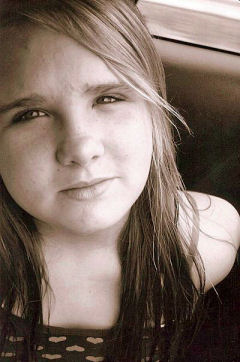
Kelly A. TanisBlue Ash, OhioLast spring, my vibrant, quirky fourteen-year-old niece, Shelby, came down with the flu — the same nasty flu that her cousins and siblings passed around for weeks. The next evening, at 11 p.m., Shelby took her last unaided breath. Upon arrival at the hospital, Shelby’s blood sugar level was over 2,000 mg/dl. (The American Diabetes Association recommends a fasting blood glucose of 70-130 mg/dl.) Even though her heart was re-started, and a ventilator pumped oxygen through her lifeless body, her brain swelled, and her organs continued to shut down. At 3:15 p.m., on March 15, 2009, Shelby Nicole Cowan passed away. Undiagnosed diabetes took this incredible, happy girl from us. During the days and weeks following her death, we saw several potential clues that had been missed, but there were compelling reasons we remained unaware of what was happening to her. Shelby occasionally complained about things looking "fuzzy" or "blurry." Poor eyesight runs in the family, so her mom set an appointment with the optometrist. Later, those of us with bad eyes realized we didn’t understand things looked "fuzzy" or "blurry" until after we put on our first pair of glasses. My daughter, Caitlin, remembered Shelby preferring ice water to her usual soda, and that she had talked about things "tasting funny." We attributed an increased thirst to warming weather and the novelty of our new refrigerator’s built-in water dispenser. Shelby was slightly overweight but was athletic and energetic, and we thought her slimming down went hand-in-hand with her recent growth spurt. When the vomiting started, the doctor said to keep her hydrated and call back if her fever spiked too high, but it stayed within the normal range, and she kept down Gatorade and applesauce (though we now understand that it worsened her condition). After visiting with her that afternoon, my daughter said Shelby was sicker than my son, Christian, who was finally recovering from that nasty flu. Caitlin said Shelby couldn’t stop throwing up, and hours before she died, her mom told me she had never seen her so sick. I reassured her that Christian was feeling better, and we shared a quick laugh about what a "drama queen" Shelby could be. None of us had any idea she was dying. In defense of our ignorance, our family had never been impacted by diabetes before. The typical awareness posters seemed to describe this disease like a predator seeking out obese and over-indulgent children whose dreadful habits might someday lead to a variety of diabetic maladies. Lists of risky behaviors or lifestyles didn’t describe Shelby, and the early warning signs seemed reminiscent of any pre-pubescent kid. After she passed, the doctors assured us that nothing could have saved her — even if we had brought her to the hospital sooner. Diabetes was to blame, but the "IF ONLY’S" continue to plague us. IF ONLY we had put the pieces together. IF ONLY Shelby knew her symptoms weren’t quite normal. IF ONLY we had been more aware or better educated, we might have saved her. And so we are sharing her story. We are keeping her memory alive in hopes of keeping someone else alive. We’ve learned that diabetes is not just a disease that might haunt us late in life after we have abused our bodies for decades. It is a subtle, sneaky condition that fools us by mimicking life’s everyday maladies while it erodes our organs and kills us from the inside out. No one fully understands how it develops, why it strikes, or who will be next. We hope to stop diabetes from taking someone else’s Shelby.....IF ONLY she is remembered. |
